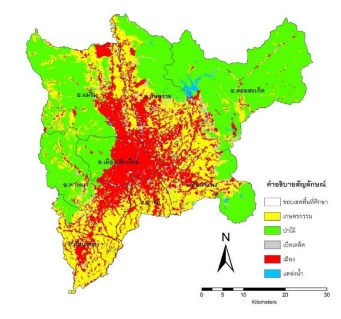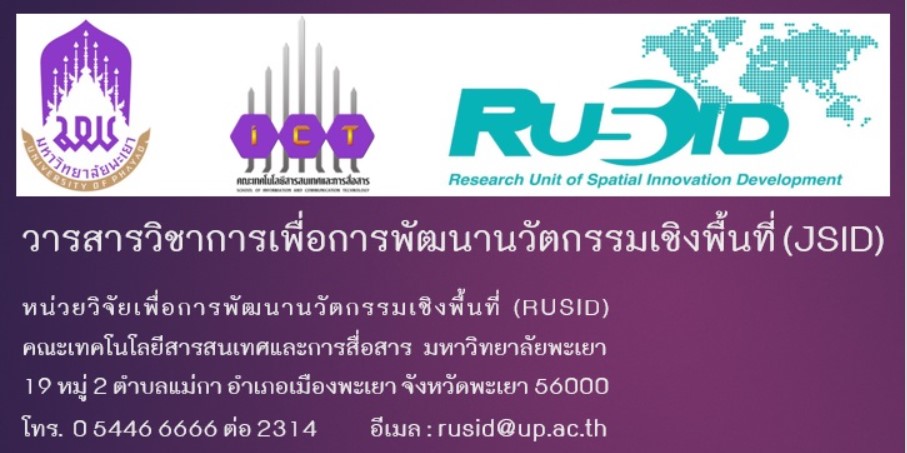การตรวจสอบความถูกต้องแบบจำลอง FLUS และคาดการณ์การใช้ประโยชน์ที่ดินในพื้นที่เมืองเชียงใหม่และเขตปริมณฑล
คำสำคัญ:
การใช้ประโยชน์ที่ดิน, ปัจจัยทางกายภาพ, มาร์คอฟ, จีโอเอสโอเอสฟรัสบทคัดย่อ
การใช้ประโยชน์ที่ดินเป็นการแสดงถึงพื้นที่เชื่อมโยงสัมพันธ์ของปัจจัยทางกายภาพ สังคม การเมือง และเทคโนโลยี การศึกษาครั้งนี้มีวัตถุประสงค์ 1) ศึกษาการเปลี่ยนแปลงการใช้ประโยชน์ที่ดินกรมพัฒนาที่ดิน ปี พ.ศ. 2549, 2552 และ 2558 2) ตรวจสอบความถูกต้องของ FLUS Model 3) คาดการณ์การใช้ประโยชน์ที่ดินปี พ.ศ. 2567 การหาความสัมพันธ์ปัจจัยกับการใช้ประโยชน์ที่ดินด้วย Artificial neural network: ANN และใช้ภาพจำลองเหตุการณ์ในอนาคตจาก Model Markov เพื่อใช้คาดการณ์อนาคต ผลการวิจัยพบว่า การเปลี่ยนแปลงการใช้ประโยชน์ที่ดินกรมพัฒนาที่ดิน ปี พ.ศ.2549 – 2552 เกษตรกรรมลดลง 34,453 ไร่ ป่าไม้ลดลง 748 ไร่ เบ็ดเตล็ดเพิ่มขึ้น 1,830 ไร่ สิ่งปลูกสร้างเพิ่มขึ้น 29,922 ไร่ และแหล่งน้ำเพิ่มขึ้น 3,449 ไร่ ปี พ.ศ. 2552 – 2558 เกษตรกรรมลดลง 6,356 ไร่ ป่าไม้ลดลง 2,460 ไร่ เบ็ดเตล็ดลดลง 5,648 ไร่ สิ่งปลูกสร้างเพิ่มขึ้น 13,210 ไร่ และแหล่งน้ำเพิ่มขึ้น 1,254 ไร่ เปลี่ยนแปลงในระยะยาว ปี พ.ศ. 2549 – 2558 เกษตรกรรมลดลง 40,809 ไร่ ป่าไม้ลดลง 3,208 ไร่ เบ็ดเตล็ดลดลง 3,818 ไร่ สิ่งปลูกสร้างเพิ่มขึ้น 43,132 ไร่ และแหล่งน้ำเพิ่มขึ้น 4,703 ไร่ และผลการคาดการณ์การใช้ประโยชน์ที่ดินปี พ.ศ. 2558 - 2567 เกษตรกรรมลดลง 19,521 ไร่ ป่าไม้ลดลง 6,268 ไร่ เบ็ดเตล็ดลดลง 7,386 ไร่ สิ่งปลูกสร้างเพิ่มขึ้น 35,013 ไร่ และแหล่งน้ำลดลง 1,838 ไร่ ดังนั้นสามารถนำฐานข้อมูลไปใช้ในการวางแผนจัดการใช้ที่ดินในอนาคตบริเวณพื้นที่เมืองเชียงใหม่และเขตปริมณฑล
เอกสารอ้างอิง
Ashraf, M. D., & Yamaguchi, Y. (2009). Land use and land cover change in Greater Dhaka, Bangladesh: Using remote sensing to promote sustainable urbanization. Applied Geography, 29(3), 390-401.
Brinkmann, k., Schumacher, J., Dittrich, A., Kadaore, I., & Buerkert, A. (2012). Analysis of landscape transformation processes in and around four West African cities over the last 50 years. Landscape and Urban Planning, 105(1-2), 94-105.
Chena, Y., Li, X., Liua, X., Ai, B., & Li, S. (2016). Capturing the varying effects of driving forces over time for the simulation of urban growth by using survival analysis and cellular automata. Landscape and Urban Planning, 152, 59–71.
Hyandye, C. & Martz, L. W. (2017). A Markovian and cellular automata land-use change predictive Model of the Usangu Catchment. International Journal of Remote Sensing, 38(1), 64-81.
Iamchuen, N. & Thepwong, W. (2020). Relationship between Physical Factors and Land Use for the Future Land Use Prediction. Journal of Architectural Planning Research and Studies. 17(2): 79-92.
Kiriwongwattana, K. (2007). Application of Clue-S Model for Land Use and Land Cover Changes Projection at Mae Yod Watershed, Maechaem District, Chiang Mai Province. Kasetsart University.
Khongouan, W. & Khamwachirapithak, P. (2020). Park Area Development Plan in Response to the Government Policies and Standards: Case Study of Krathumbaen Municipality, Samut Sakhon. Journal of Architectural/Planning Research and Studies. 17(2), 111-128.
Lambin, EF. et.al. (2001). The causes of land-use and land-cover change: Moving beyond the myths. Global Environmental Change. 11(4), 261–269.
Lanchanon, P. (2013). The Potential of Agricultural Lands for Conservation of Green Area in Chiang Mai City. Journal of Architectural/Planning Research and Studies. 10(2), 115-137.
Li, X. & Anthony, G. (2002). Urban Simulation Using Neural Networks and Cellular Automata for Land Use Planning. Springer-Verlag Berlin Heidelberg. 451-465.
Lianga, X., Liua, X., Lib, a. X., Chenb, Y., Tiana, H., & Yao, Y. (2018). Delineating multi-scenario urban growth boundaries with a CA-based FLUS Model and morphological method. Landscape and Urban Planning, 177, 47–63.
Liu, X., Li, X. & Liang, X. (2020). A Future Land Use Simulation Model by coupling Human and Natural Effects. GeoSOS-FLUS User's Manual.
Muhammad, H. S. & Han, S. L. (2019). Prediction of Land Use and Land Cover Changes for North Sumatra, Indonesia, Using an Artificial-Neural-Network-Based Cellular Automaton. Sustainability, 11(11), 1-16.
Pumchan, S., Trisuratand, Y. & Pipatwattanakul, D. (2014). Application of clue – s model and globio 3 model in the assess of land use change on biodiversity. Kasetsart University.
Ruensukon, T., Trisurat, Y., Tangtham, N., & Tokrisna, R. (2016). Valuation of ecosystem services in Klongchumphon watershed, Ranong and Chumphon province. Thai Journal of Forestry (Thailand).
Suppawimut, W. (2018). Agricultural land losses in surrounded area of chiang mai middle ring road. VRU Research and Development Journal Science and Technology. 13(3),103-113.
Thepwong, W. & Chakaew, N. (2019). Application on spatial models for land use prediction. The 4th Conference on Natural Resources, Geoinformation and Environment. 455-461.
Turner, II B.L., Skole, D., Sanderson, S., Fischer, G., Fresco, L. & Leemans, R. (1995). Land use land cover change. science/research plan (IGBP Report No. 35 and HDP Report No.7).
Vanno, S. (2012). Bangkok’s Green Infrastructure. Journal of Architectural/Planning Research and Studies. 9(2), 1-13.
Wang, Y., Xu, T., Lv, X., & Zhang, Z. (2016). Simulation of Land Use Dynamic Change using selected driving factors based on the method of Feature Selection. Advances in Engineering Research, 3, 855-860. 35(1), 62-73.





